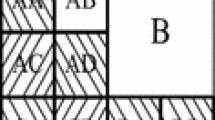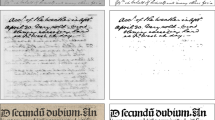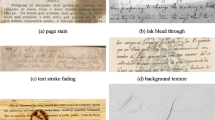Abstract
Preprocessing for degraded document images can improve their binarization result. Sharpening and illumination compensation are effective methods in preprocessing. We find the degree of sharpening has different effects on the different stroke width. As the degree of sharpening increases, the thin strokes retained more information in the binarization results, while the thick strokes gradually appear to be broken. Aiming at this problem, we propose a local adaptive sharpening method. The stroke width estimation algorithm is utilized to estimate the stroke width in the local region. Local adaptive sharpening is performed to solve the problem of thick stroke fracture and retain more information of thin strokes. In addition, comparing with the weakly illuminated document images, the sharpening effects on strongly illuminated document images are more prominent, and the binarization result is better. Therefore, appropriate illumination compensation is used for weakly illuminated document images. We further propose a preprocessing method for degraded document image using local adaptive sharpening and illumination compensation. The experimental results show that our proposed method restores more detail information and keeps the thick stroke information in binarization result. Our method outperforms U-Net without preprocessing by 0.36% FM scores on DIBCO2016, 1.09% FM scores on DIBCO2017 and 1.42% FM scores on DIBCO2018. U-Net, Sauvola and OTSU combined with our LASIC outperform themselves by 1.42%, 0.29% and 5.41% FM scores on DIBCO2018. And our LASIC method outperforms other preprocessing methods by 0.1% to 1.05% FM scores on DIBCO2016-DIBCO2018.











Similar content being viewed by others
References
Sulaiman A, Omar K, Nasrudin MF (2019) Degraded historical document binarization: a review on issues, challenges, techniques, and future directions. J Imag 5(4):48
Huang X, Li L, Liu R et al (2020) Binarization of degraded document images with global-local U-Nets. Optik 203:164025
Zhao J, Shi C, Jia F et al (2019) Document image binarization with cascaded generators of conditional generative adversarial networks. Pattern Recogn 96:106968
Dyla MHM, Morain-Nicolier F (2019) Text line segmentation and binarization of handwritten historical documents using the fast and adaptive bidimensional empirical mode decomposition. Optik 188:52–63
Calvo-Zaragoza J, Gallego AJ (2019) A selectional auto-encoder approach for document image binarization. Pattern Recogn 86:37–47
Ntirogiannis K, Gatos B, Pratikakis I (2014) A combined approach for the binarization of handwritten document images. Pattern Recogn Lett 35(1):3–15
Mitianoudis N, Papamarkos N (2015) Document image binarization using local features and Gaussian mixture modeling. Image Vision Comput 38:33–51
Mandal S, Das S, Agarwal A, et al (2015) Binarization of degraded handwritten documents based on morphological contrast intensification. In: 2015 Third international conference on image information processing (ICIIP). IEEE, pp. 73–78
Ranganatha D, Holi G(2015) Hybrid binarization technique for degraded document images. In: 2015 IEEE International advance computing conference (IACC). IEEE, pp. 893–898
Chen Y, Wang L (2017) Broken and degraded document images binarization. Neurocomputing 237:272–280
Nevriyanto A, Purnamasari D(2017)Image enhancement using the image sharpening, contrast enhancement, and Standard Median Filter (Noise Removal) with pixel-based and human visual system-based measurements. In: 2017 International conference on electrical engineering and computer science (ICECOS). IEEE, pp. 114-119
Vo GD, Park C (2018) Robust regression for image binarization under heavy noise and nonuniform background. Pattern Recogn 81:224–239
Miao S, Lu T, Min F(2015) Binarization algorithm for document image with complex background. In: MIPPR 2015: Pattern Recognition and Computer Vision. International Society for Optics and Photonics 9813: 981318
Long J, Shelhamer E, Darrell T(2015) Fully convolutional networks for semantic segmentation. In: Proceedings of the IEEE conference on computer vision and pattern recognition, pp. 3431-3440
Tensmeyer C, Martinez T (2017) Document image binarization with fully convolutional neural networks. In: 2017 14th IAPR International conference on document analysis and recognition (ICDAR). IEEE, 1: 99-104
Ronneberger O, Fischer P, Brox T (2015) U-net: Convolutional networks for biomedical image segmentation. International conference on medical image computing and computer-assisted intervention. Springer, Cham, pp 234–241
Abraham N, Khan NM (2019) A novel focal tversky loss function with improved attention u-net for lesion segmentation. In: 2019 IEEE 16th International symposium on biomedical imaging (ISBI), IEEE 2019, pp. 683–687
Liu Y, Qi N, Zhu Q, et al (2019) CR-U-Net: Cascaded U-Net with Residual Mapping for Liver Segmentation in CT Images. In: 2019 IEEE visual communications and image processing (VCIP). IEEE, pp. 1–4
Liu W, Sun Y, Ji Q (2020) Mdan-unet: multi-scale and dual attention enhanced nested u-net architecture for segmentation of optical coherence tomography images. Algorithms 13(3):60
Shibuya E, Hotta K (2020) Feedback U-Net for cell image segmentation. In: Proceedings of the IEEE/CVF Conference on computer vision and pattern recognition workshops, pp. 974-975
Pratikakis I, Zagoris K, Barlas G, et al(2017) ICDAR2017 competition on document image binarization (DIBCO 2017). In: 2017 14th IAPR International conference on document analysis and recognition (ICDAR). IEEE, 1: 1395-1403
Pratikakis I, Zagoris K, Kaddas P et al (2018) IEEE, ICFHR 2018 competition on handwritten document image binarization (H-DIBCO 2018). In: Proceedings 2018 16th International conference on frontiers in handwriting recognition, pp. 489-493
I. Pratikakis, K. Zagoris, X. Karagiannis, L. Tsochatzidis, T (2019) Mondal and I. Marthot-Santaniello,“ICDAR 2019 competition on document image binarization (DIBCO 2019). In: 2019 International conference on document analysis and recognition (ICDAR) , pp. 1547-1556, https://doi.org/10.1109/ICDAR.2019.00249.
Kang S, Iwana BK, Uchida S (2021) Complex image processing with less data-Document image binarization by integrating multiple pre-trained U-Net modules. Pattern Recogn 109:107577
Pratikakis I, Zagoris K, Barlas G et al (2017) ICFHR2016 Handwritten document image binarization contest (H-DIBCO 2016). In: International conference on frontiers in Hhndwriting recognition. IEEE
Sauvola J, Pietikainen M (2000) Adaptive document image binarization. Pattern Recogn 33(2):225–236
Otsu N (1979) A threshold selection method from gray-level histograms. IEEE Trans Syst, Man, Cybern 9(1):62–66
Wagdy M, Faye I, Rohaya D(2013) Fast and efficient document image clean up and binarization based on retinex theory. In: 2013 IEEE 9th International colloquium on signal processing and its applications. IEEE, pp. 58–62
Powers D M W(2020) Evaluation: from precision, recall and F-measure to ROC, informedness, markedness and correlation. arXiv preprint arXiv:2010.16061,
Sara U, Akter M, Uddin MS (2019) Image quality assessment through FSIM, SSIM, MSE and PSNR-a comparative study. J Comput Commun 7(3):8–18
Author information
Authors and Affiliations
Corresponding author
Additional information
Publisher's Note
Springer Nature remains neutral with regard to jurisdictional claims in published maps and institutional affiliations.
Rights and permissions
About this article
Cite this article
Wang, H.X., Song, B., Chen, J. et al. Degraded document image preprocessing using local adaptive sharpening and illumination compensation. Pattern Anal Applic 25, 125–137 (2022). https://doi.org/10.1007/s10044-021-01038-z
Received:
Accepted:
Published:
Issue Date:
DOI: https://doi.org/10.1007/s10044-021-01038-z




